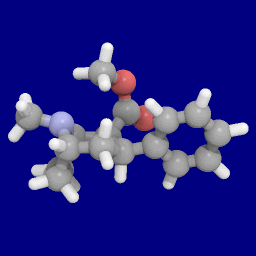Phenyltropane
Phenyltropane is a class of synthetic stimulants that are chemically related to cocaine. These compounds are derived from the tropane alkaloid found in the Erythroxylum coca plant, from which cocaine is also derived. Phenyltropanes are known for their high affinity for the neurotransmitter reuptake transporters, including the dopamine, serotonin, and norepinephrine transporters. This affinity makes them potent inhibitors of these transporters, leading to increased concentrations of these neurotransmitters in the synaptic cleft and resulting in stimulant and euphoric effects.
Chemistry[edit | edit source]
Phenyltropanes are characterized by the presence of a phenyl ring attached to the tropane skeleton. The chemical structure of phenyltropanes allows for a high degree of structural variability, leading to the synthesis of numerous analogs with varying pharmacological profiles. The modifications to the phenyl ring or the tropane moiety can significantly alter the potency, selectivity, and duration of action of these compounds.
Pharmacology[edit | edit source]
The primary mechanism of action of phenyltropanes involves the inhibition of neurotransmitter reuptake transporters. By blocking the reuptake of dopamine, serotonin, and norepinephrine, phenyltropanes increase the concentration of these neurotransmitters in the synaptic cleft, enhancing neurotransmission and producing stimulant effects. The affinity of phenyltropanes for these transporters can vary significantly among different analogs, influencing their pharmacological effects.
Clinical Use and Abuse Potential[edit | edit source]
While some phenyltropanes have been researched for potential therapeutic applications, such as in the treatment of Attention Deficit Hyperactivity Disorder (ADHD) and obesity, their high potential for abuse and addiction has limited their clinical use. The stimulant effects of phenyltropanes, similar to those of cocaine, make them susceptible to recreational abuse, leading to various adverse health effects, including cardiovascular problems, neurological damage, and psychological dependence.
Legal Status[edit | edit source]
Due to their potential for abuse and the health risks associated with their use, many phenyltropanes are classified as controlled substances under various national and international laws. The legal status of specific phenyltropanes can vary by country, but many are regulated under drug control policies to prevent their non-medical use.
Research[edit | edit source]
Research on phenyltropanes continues to explore their pharmacological properties, potential therapeutic applications, and mechanisms of action. Studies aim to develop analogs with reduced abuse potential and improved safety profiles for potential medical use. However, the challenge remains to balance the therapeutic benefits of these compounds with their risks of abuse and adverse effects.
Search WikiMD
Ad.Tired of being Overweight? Try W8MD's physician weight loss program.
Semaglutide (Ozempic / Wegovy and Tirzepatide (Mounjaro / Zepbound) available.
Advertise on WikiMD
|
WikiMD's Wellness Encyclopedia |
| Let Food Be Thy Medicine Medicine Thy Food - Hippocrates |
Translate this page: - East Asian
中文,
日本,
한국어,
South Asian
हिन्दी,
தமிழ்,
తెలుగు,
Urdu,
ಕನ್ನಡ,
Southeast Asian
Indonesian,
Vietnamese,
Thai,
မြန်မာဘာသာ,
বাংলা
European
español,
Deutsch,
français,
Greek,
português do Brasil,
polski,
română,
русский,
Nederlands,
norsk,
svenska,
suomi,
Italian
Middle Eastern & African
عربى,
Turkish,
Persian,
Hebrew,
Afrikaans,
isiZulu,
Kiswahili,
Other
Bulgarian,
Hungarian,
Czech,
Swedish,
മലയാളം,
मराठी,
ਪੰਜਾਬੀ,
ગુજરાતી,
Portuguese,
Ukrainian
Medical Disclaimer: WikiMD is not a substitute for professional medical advice. The information on WikiMD is provided as an information resource only, may be incorrect, outdated or misleading, and is not to be used or relied on for any diagnostic or treatment purposes. Please consult your health care provider before making any healthcare decisions or for guidance about a specific medical condition. WikiMD expressly disclaims responsibility, and shall have no liability, for any damages, loss, injury, or liability whatsoever suffered as a result of your reliance on the information contained in this site. By visiting this site you agree to the foregoing terms and conditions, which may from time to time be changed or supplemented by WikiMD. If you do not agree to the foregoing terms and conditions, you should not enter or use this site. See full disclaimer.
Credits:Most images are courtesy of Wikimedia commons, and templates, categories Wikipedia, licensed under CC BY SA or similar.
Contributors: Prab R. Tumpati, MD

